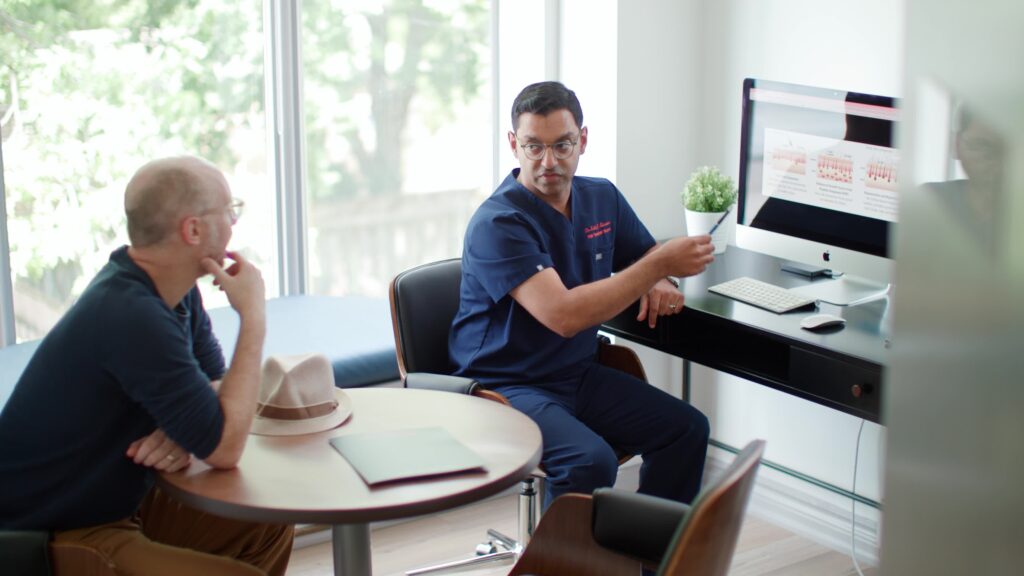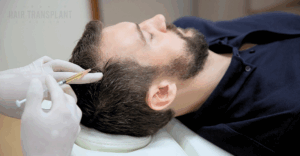Hair loss can be a distressing experience, leading many to explore the option of a hair transplant to restore their hairline and confidence. However, the journey to a successful hair transplant often begins with numerous questions. Before deciding to proceed, potential patients research and question the details about the procedure, expected results, and recovery timelines as a few of their top concerns. This article delves into the top 10 questions people commonly ask hair transplant doctors, aiming to provide you with the information you need to make an informed choice answered by actual hair transplant doctors.
People want to know how effective hair transplants are and what kind of results they can realistically expect. So the (surprise) number one question people ask is: What is the success rate of hair transplants?
In the hands of a skilled surgical team, the expectation is that 95% or more of the transplanted grafts will grow when planted into an area that’s never been transplanted before. Of course, this high success rate depends on the skill and experience of your surgical team at every step of your transplant. The success rate of your grafts depends on several factors:
- GRAFT HEALTH: Grafts must be extracted completely and without damage. At THTS, we inspect EVERY SINGLE GRAFT before transplanting, and we don’t use the small number that might have been damaged.
- GRAFT STORAGE: Grafts are temporarily stored in a cooled solution that mimics the environment of your scalp until they’re ready to be planted.
- GRAFT DENSITY: Planting grafts with too little density can result in an overall thin appearance, but believe it or not, planting grafts with too much density can also result in a poor outcome. Packing in too many grafts into a given area can result in those grafts competing for the things they need to stay alive, resulting in more of them dying. You might think of this as planting too many plants in your garden. Overcrowding means they won’t have what they need to survive (space, air flow, sunlight etc) and many might die. Packing hair grafts too densely can also result in other complications like an increased chance of infection or necrosis (death) of the skin. These complications can also result in a poor outcome. In a hair transplant, the goal is to transplant as many grafts as safely possible in a given area and this is a determination your surgeon will help you make.
- PREVIOUS SURGERY: Planting grafts into scar tissue or an area that’s previously been transplanted usually works well, but can result in a slightly lower graft survival rate. This is something we have managed in our clinic before and through experience, we believe that following up such a surgery with PRP can help more grafts survive.
Cost remains a major concern, with patients wanting to understand the price range and what influences the overall expense. To be honest, we were expecting this to be the top question. That said, coming in at #2: How much does a hair transplant cost?
The cost of a hair transplant can vary depending on the type of surgery you have (FUE vs. FUT) and the number of grafts in that surgery. Generally speaking, the more grafts, the higher the cost.
The cost of your surgery can also vary depending on the skill and experience of your surgical team. Surgery performed directly by a highly skilled and experienced surgeon is likely to cost a little more than surgery performed by an unskilled technician, a surgeon with little experience, or someone who may be more experienced with other cosmetic procedures.
Unfortunately, most low-to-moderate cost surgeries overseas and even in Canada are delegated to low-skill technicians to keep the costs down. At THTS, our surgeries are performed directly by our experienced surgeons, who each personally perform hundreds of surgeries each year. Depending on the nature of the surgery, surgical pricing may range from $6,000 to $18,000 or more.
For those with a more limited budget, THTS does offer technician-led surgeries for less. In contrast to other clinics that offer technician-led surgeries, our surgeons are still directly involved in your THTS technician-led surgery including hairline design and equipment selection, and your entire procedure is closely supervised by your surgeon.
Before venturing too far down the list of things to investigate, potential patients are eager to know if their hair loss pattern, age, or overall health make them suitable candidates for the procedure. Answering this question near the top of the list can spare the person time and false hope. #3 is: Am I a good candidate for a hair transplant?
The best way to know if you’re a good candidate for a hair transplant is to meet with a knowledgeable surgeon or Hair Restoration Expert. Every case is unique, and everyone’s goals are different. Your THTS surgeon or Hair Restoration Expert will work with you to understand your goals and determine if they can be safely met. Viewed another way, your surgeon or Hair Restoration Expert can look at your available donor area and tell you what goals can be realistically accomplished. Even people with advanced hair loss are sometimes surprised at what we can do!
The reality is that most people with hair loss are candidates for a hair transplant. In the hands of an experienced surgeon who has seen every pattern of hair loss many times over, there aren’t very many cases in which someone is truly not a candidate for any kind of hair restoration.
The above said it is best to tackle the problem relatively early, for a hair transplant, rather than waiting until you’ve lost too much hair. The more we have to work with, the better!
So, you’ve been doing your research and due diligence and have collected enough information to know that you should qualify to pursue a hair transplant surgery. What is the recovery time after a hair transplant? Understanding the recovery process, including how long it takes and what activities to avoid, is a common inquiry and comes in at #4 on our top 10 essential questions about hair transplants.
There are two types of recovery that we talk about after a hair transplant, physical and cosmetic recovery.
In physical recovery, we’re talking about things like how long will it take for things to heal, and how quickly can I get back to my usual activities.
Hair transplant surgery does not require bed rest or avoidance of most of your day-to-day activities like working from home, getting groceries, walking the dog, or picking up the kids from school. You can even resume strenuous workouts as early as 10 days after your surgery.
In cosmetic recovery, we’re talking about things like how long will it take before I don’t look like I’ve had surgery.
For most cases, this is about 10 days. By that time, the small incisions in your scalp will have healed and scabbing and crusting should be gone. If you’ve had an FUE procedure that required shaving, you may still have short hair, but this will continue growing at its normal pace. For some people this cosmetic recovery can be a little shorter, and for some a little longer. At THTS we can give you some advice unique to you in terms of how best to conceal the effects of your surgery without jeopardizing your results.
Unsurprisingly, potential patients want to know: Are the results of a hair transplant permanent? Patients frequently ask about the longevity of the results and whether they will need future procedures. This question came in at number five in our poll and we understand why permanence and cost concerns are tied to this one question.
When performed by a skilled and experienced surgical team, your transplanted hair should last a lifetime. This is because the follicles that are chosen for transplant are harvested from a genetically permanent pool of donor follicles, and they maintain that genetic permanency wherever they are transplanted. These follicles are not subject to the same processes that caused your other hair to become thin, so these follicles will maintain their ability to grow forever.
Unfortunately, unskilled surgical teams sometimes don’t know how to properly assess the donor area and they may harvest hair from future areas of hair loss to increase their total graft yield. If non-permanent hairs are chosen for transplant, these may be lost at a later date. Depending on where those non-permanent hairs were transplanted, the result can be patchy and unnatural in appearance.
As to future surgeries, it is possible to have more than one surgery in your lifetime depending on the quality and number of donor grafts. Additional surgeries may be pursued in cases where additional coverage is desired. Some patients are reserved in their approach, and upon a successful first transplant, will choose to pursue additional intervention.
At THTS, we also go to great lengths to educate and discuss with you the most effective ways to help you keep the hair you still have, and even thicken some of your existing thinning hair. In some cases, you can even regrow new hair! The overall result is permanent hair that will last a long, long time.
Safety concerns are paramount when anyone is considering surgery, with many people asking about possible complications or side effects of the surgery. A qualified and experienced surgical team should expect this #6 question. What are the potential risks or side effects?
Fortunately, risks and side effects of surgery when performed by a skilled and experienced surgical team are rare. Even the “common” ones, like minor skin infections, are rare and are easily treatable. Other “common” side effects like shock loss, numbness, or itching occur infrequently and usually resolve on their own. At THTS, we are always available to follow along with you through your recovery course to identify any potential problems early and help you resolve them.
Side effects are more common in procedures that are performed by low-skill teams or by clinics for whom follow-up is more difficult.
Cosmetically speaking, the most serious side effect would be that a significant number of your grafts fail to grow, a process called “graft failure”. The cause is unknown, but luckily this occurs much less than 1% of the time. At THTS, you will receive a fully detailed list of the possible risks and complications of your surgery which you can review with your surgeon before your procedure.
The number seven question is: How natural will the results look? Ensuring that the transplanted hair looks natural and blends seamlessly with existing hair is a key concern for most patients. Although societal pressure and stigma have changed in recent years, there is still a desire for most patients to have a virtually undetectable intervention.
The entire point of a hair transplant is to restore your hair to a natural appearance. If it doesn’t look natural, why do it? At THTS, this is our main focus. Our goal is not to try to make you look 20 years old again, give you the blocky hair of a LEGO minifig, or give you any other kind of unnatural appearance. Nothing says “I’ve had a hair transplant!” like a hairline that’s too low or too straight for your face or has a shape that isn’t found commonly in nature.
The first step to a natural appearance is for us to understand your goals and give you a realistic assessment of what a hair restoration can accomplish. There are no one-size-fits-all or cookie-cutter solutions for hair restoration. We consider a variety of factors such as your age, the progress and status of your hair loss, other treatments you might be using to prevent hair loss or regrow your hair, and your anatomical features such as the position of your forehead muscles and your eyes. If your surgical team doesn’t understand these factors and is designing the same hairline for everyone, or simply throwing a large number of grafts at you, this is a red flag for a team that doesn’t understand how to craft natural results.
The next step is to use that information to select the appropriate surgical procedure, and the right number of grafts, and to set you up with a custom supplementary therapy plan to optimize the result of your surgery.
If you’ve done almost any research into hair transplants, then you’ve been waiting for the number eight question: What is the difference between FUE and FUT hair transplant techniques? Most individuals seek to understand the distinctions between different transplant methods and which one might be better for their situation.
The key thing to understand here is that the differences in techniques relate only to the way the follicles or grafts are harvested. In both surgeries, grafts are planted identically, and in modern hair transplantation by a skilled and experienced team, both techniques have an excellent success rate.
Today, FUEs the more common surgery but that doesn’t mean it’s the best surgery for everyone. In FUE, follicles are extracted diffusely and randomly from your donor area one by one. The result is typically thousands of very small incisions throughout the donor area, each usually less than 1mm in diameter. These heal up quickly in a matter of days leaving only a very small scar that is nearly imperceptible to the naked eye, especially when there is some surrounding hair that is at least a few millimetres long. If you were to shave your head right down to the skin, these scars might be visible, especially if you’ve had a very large FUE surgery.
An FUE surgery allows you to avoid a linear scar in your donor area which, in turn, allows you to continue to wear your hair very short, in many cases even as short as a #1 clipper.
An FUT, or “strip” surgery, might be more appropriate for people who have a smaller band of thick donor hair. In this method, a narrow strip of hair-containing scalp is excised from the donor area. This strip is then dissected under the microscope into individual follicles for planting into your thinning areas. The scalp is then sewn back (stitched) together. The result is that a high number of grafts can often be harvested from a small donor area. In some cases, graft quality can be better with FUT than with the FUE technique. FUT/strip surgery does leave a thin linear scar at the back of the head, but this is hidden by the surrounding hair so long as that hair is about 1cm long. Even immediately after surgery, the stitches are imperceptible. Patients having this type of surgery might not be able to cut their hair very short in the future (you would need to keep your hair at a #3 or #4 guard on the clippers), but it does allow for a large harvest of follicles in someone who might have a smaller donor area.
At THTS, your surgeon or Hair Restoration Expert will tell you about the pros and cons of each surgical approach in your unique case, and make a recommendation for you to help you decide between them.
Coming in at number nine on our list: How many grafts will I need? Patients are naturally curious about the number of hair grafts they will need to achieve their desired results. As this factor also affects the likely cost of the procedure, having a realistic expectation and estimate is important.
The number of grafts you need will depend on the stage of your hair loss and the goals of your hair transplant. Two people with identical hair loss may have very different goals for their hair restoration, and their graft needs will be different. Those two people may even have very different hair, which might also affect their graft needs.
But there’s more to it than that, factors that go beyond simply noting the area that needs more density. For example, the texture of your hair. Is it fine, and will more grafts be needed to cover a certain area? Or is it coarse and curly, such that fewer grafts can give the same cosmetic coverage? Do you have existing hair in the area to be transplanted? How thin or thick is it? Are you using treatments to prevent hair loss or regrow some of your hair, or do we have to account for future hair loss? Have you had a hair transplant before, and is there scar tissue? How much donor hair do you have? And many more.
The reality is, that your grafts needs are going to be unique to you and your goals, and this is best determined by talking to an experienced surgeon or Hair Restoration Expert.
Similar to our number four question, the final question in our top 10 essential hair transplant questions is: How soon can I return to work after a hair transplant? Knowing when normal activities, especially returning to work, can be resumed is important for planning the procedure around their life.
For many, the answer is as early as the next day!
Ultimately, it’s going to depend on what you do for a living. Do you work behind a desk at home? Are you meeting face-to-face with people every day? Do you work outdoors in the hot sun doing strenuous work? Do you need to wear protective headwear?
In the majority of cases, most people are back to work – even strenuous work – within about 10 days of their surgery. For every person, though, the answer is a little bit different. There is no bed rest with a hair transplant, so many people can resume typical work activities even the next day, such as doing paperwork, answering emails and phone calls, and so on. Your appearance may be a little different in the days and weeks following your surgery, such as having some scabbing in the surgical area, or a shaved head. For people who cannot work without an altered appearance, more time off might be necessary. In those cases, specialized types of surgeries such as partial or no-shave surgeries might be an option to quicken your return to work.
The best way to determine your need for time off is to first have a good understanding of what a hair restoration would be like in your case. Your THTS surgeon or Hair Restoration Expert can then advise you about your return to work.
Deciding to undergo a hair transplant is a significant step, and it’s natural to have questions and concerns. By addressing the top 10 questions people ask hair transplant doctors, this article equips you with the knowledge needed to make an informed decision. Remember, the key to a successful hair transplant lies in choosing a skilled surgeon, understanding the procedure, and having realistic expectations. Your journey to hair restoration begins with asking the right questions and getting the answers you need.






